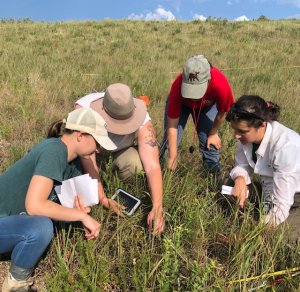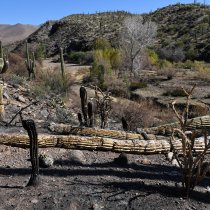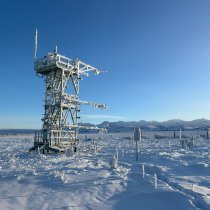Domain Digest No. 10: Seasonal Positions Across the U.S
March 6, 2024
Every year, NEON hires around 230 seasonal field technicians across the Observatory in addition to its full-time field staff. These staff are tasked with collecting field observations and physical samples at NEON field sites. They receive on-the-job training, develop field science skills that can boost their careers, and get to live and work in some of the continent’s most pristine and beautiful places.
NEON is currently hiring for seasonal positions across the country. But what do these positions entail, what are the benefits, and who should apply?
A Wild Environment for Everyone
The continental scope and scale of NEON means field staff can work in many different kinds of ecosystems that aren’t accessed by smaller research programs. NEON’s field science teams are the backbone of the observational sampling protocols for all 47 terrestrial and 34 freshwater aquatic field sites. Each of these sites has its own unique enchantments—and its challenges.
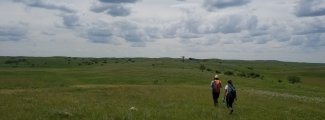
DCFS field scientists walking in the grass
NEON’s seasonal workers (Temporary Field Technicians, or TFTs) brave the elements, bugs, pokey or poisonous plants, and the occasional wildlife encounter to gather observational data, maintain instrument systems, and collect physical samples. They are outside in all weather conditions, at all times of the year. The tradeoff, however, is getting to work in environments that very few people see.
Many of the field sites are in remote areas, and the plots are frequently off-trail. Even within a single field site, there is a lot of variety among the plots, and TFTs get to experience the full scope of different landscapes and habitats found within an area. Across NEON’s 20 Domains, ecosystems vary even more widely. Technicians in Domain 20 (Hawaii) may start most days of the sampling season from the surfside town of Hilo before driving up to the Pu'u Maka'ala Natural Area Reserve for a day of plant diversity sampling, while the same position in Domain 18 (Alaska’s Tundra) may need to use a snowmobile to complete a scheduled water sample collection for microbes while spotting caribou in the distance.
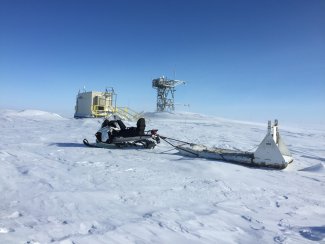
Utqiaġvik field site in the Alaskan tundra. Photo credit: Jim Hojohn.
“Being an ecologist with NEON has been a great opportunity to enjoy interesting natural areas at a level far more detailed than any recreational outing,” says Morgan Fowler, a TFT in Domain 11 (Southern Plains). “I’ve been able to appreciate so many interesting specifics and seasonality at our study sites in the past year.”
Finnegan Snead, a TFT in Domain 16 (Pacific Northwest), echoes the sentiment. “My favorite experience has been seeing the way the forest can change throughout the year, while learning how to identify rarer plant species as I become comfortable with the more ubiquitous ones. I love being able to see the orchids come up in mid spring and the lilies in early summer.”
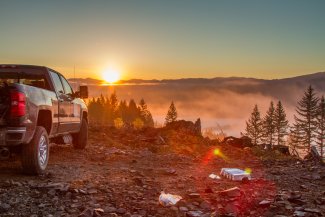
Small mammal sampling at sunrise at ABBY site, WA
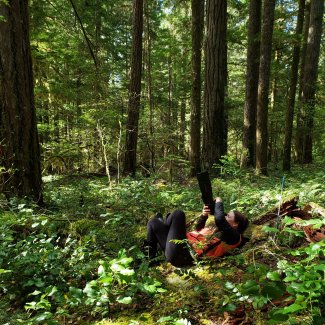
Jenni from D16 (Pacific Northwest) kicks back in some cozy moss while using a spotting scope to observe flowering and bud burst on Douglas Fir and Western Hemlock at NEON's Wind River Experimental Forest (WREF) field site in Washington.
No matter the location, seasonal field staff are immersed in nature and get a unique experience in their daily lives for the months of the regular field season.
High-Quality Training for High Quality Skills
While each field site and Domain has unique characteristics, sampling activities are standardized the same across the country. At terrestrial sites, field teams collect data on plants, small mammals, birds, insects, and soil microbes. Aquatic site observations include aquatic organism abundance and diversity, biogeochemistry, stream and lake morphology, and riparian phenology. While many technicians specialize in specific areas, most are cross trained in sampling protocols for other areas so teams are flexible and can respond to different sampling needs at different times of the year.
To ensure all staff understand and follow the protocols, TFTs undergo rigorous in-person and online training before they begin collecting samples. They are trained by experienced full-time NEON staff members, who are themselves trained through a train-the-trainer model to ensure training quality and consistency. (Read more here about training at the NEON program.)
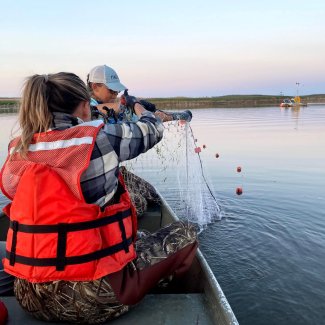
Fall fish sampling in North Dakota. NEON lake sites use three methods of catch-and-release fishing to capture a variety of species, size classes, and habitat preferences.
The NEON seasonal training program not only ensures standardized data collection across the Observatory, but also gives field technicians that they can implement in other field ecology programs or wherever their careers take them. The Ecological Society of America even offers NEON staff credits towards their Certified Ecologist Program for completing certain NEON coursework.
“The most valuable skill I’ve honed here has been adaptability in fieldwork,” says Fowler. “How you navigate sites and objectives is always dependent on factors like weather, equipment, and your team.”
Snead says, “I think my ability to navigate complex forest systems confidently, learning plants in the Pacific Northwest, and having a better understanding of what ecology work entails have been useful skills to build.”
Every attempt is made to match potential TFTs with their passions (e.g., flora vs. fauna) and let them work in the ecosystems they are most interested in. The day-to-day and even week-to-week work varies throughout the season, and if staff are not out in the field collecting data, then they are in the lab processing samples.
“As a TFT, the most useful skill I developed was the ability to pivot,” says Lark Heston, now a full-time technician in Domain 07 (Appalachian and Cumberland Plateau). “Although I started on the fauna team, in my first season I still assisted with phenology, litter, and soil protocols. I had to learn to seamlessly switch gears from week to week. Even within the fauna protocols, I might have been doing invertebrate bycatch sorting in the lab one day and the next be dragging tick clothes in the Smokies.”
Like Heston, many NEON TFTs return for second or third seasons to build upon their skills and experiences, and some go on to be hired as full-time field staff. “Although I decided to stay in Domain 07,” she recalls, “I had the option to transfer from domain to domain between seasons. I could have experienced the same job in Puerto Rico, Alaska, Colorado, and many other regions of our continent. I took it season by season and made decisions that were right for me in the moment. This led me to where I am now, as the lead field tech for the flora team! It's so well suited to me that I can't imagine having gone any other route. I took my time working many seasons as a TFT, learning all the endless skills I possibly could in NEON, and ultimately, I went with the flow.”
Becoming a Seasonal Technician
Aside from just nature lovers, who should apply to be a NEON seasonal technician? Most of the TFTs hired each year are recent undergraduates, graduate students, or early-career scientists. These seasonal opportunities are perfect for those who want to explore fieldwork and gain experience and skills while collecting data for a continental-scale ecology program. Positions start in spring (February to June) and end in autumn (August to November); exact dates are based on sampling schedules in each Domain and vary by location.
As for what new hires should expect? “Over-preparedness is never the wrong move,” says Fowler. “When possible, give yourself the gift of your best possible training, study, equipment, physical conditioning, etc. That extra water bottle or supply list check might be the difference between an easy day or a challenging day.” Snead recommends wearing sunscreen, getting a good pair of rain boots, posting on iNaturalist, keeping your mind open, and allowing yourself to be immersed in and entertained by nature.
NEON is currently hiring TFTs for 2024 in many of our Domains. Browse our open TFT positions on Battelle Careers and apply today!
